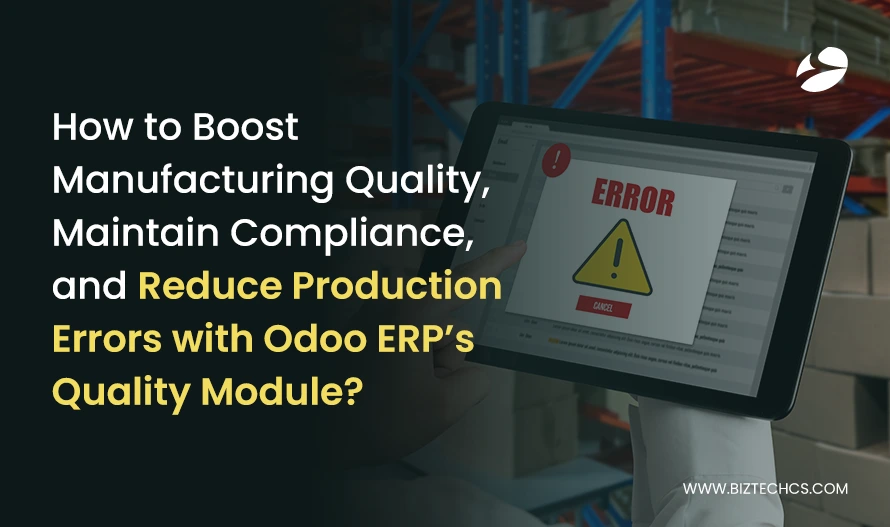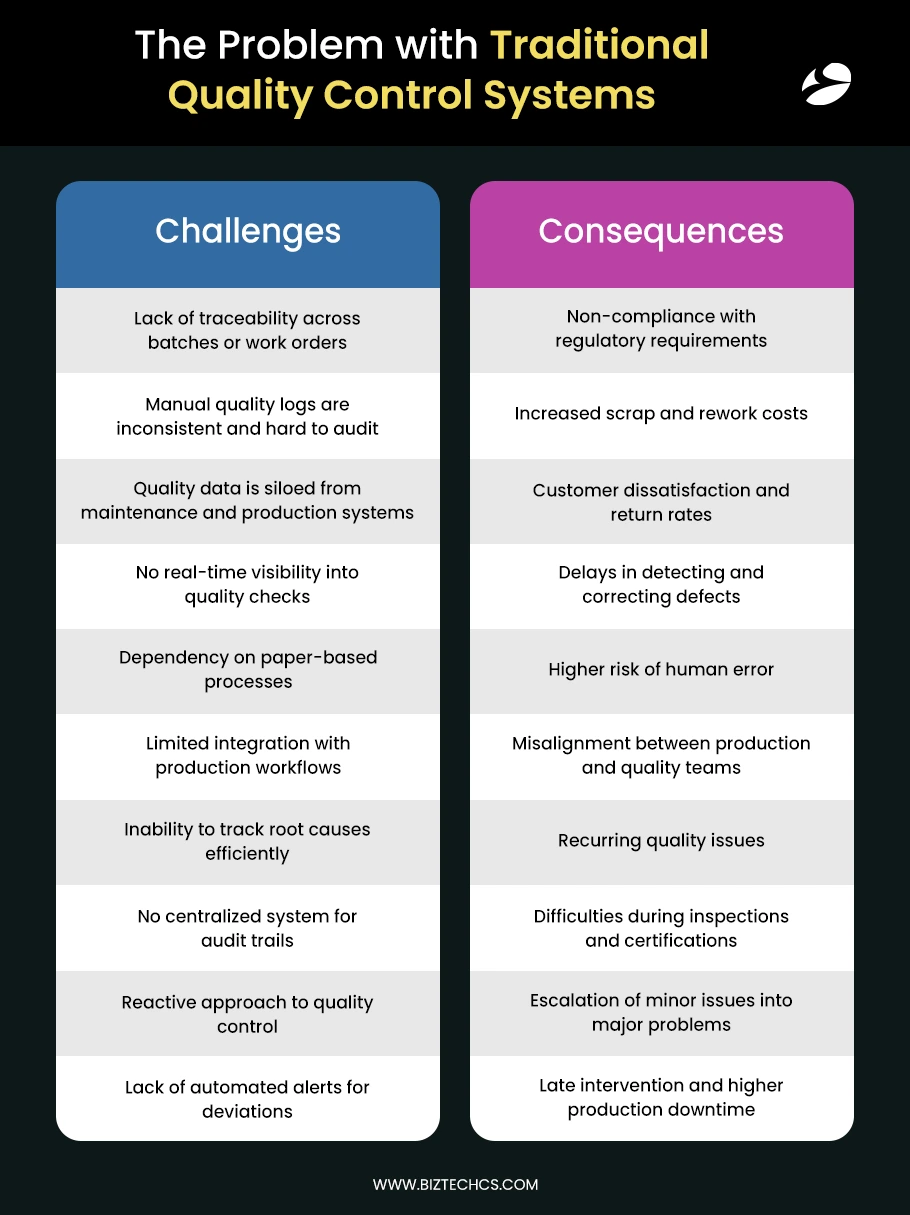3035
How to Boost Manufacturing Quality, Maintain Compliance, and Reduce Production Errors with Odoo ERP’s Quality Module?
06 Jun, 2025
5 min read
3035
06 Jun, 2025
5 min read
Table of Content

Defects that recur can silently undermine product value and customer confidence. In most factories, the issue isn’t how quality is defined—it’s how it’s being tracked. Inspection logbooks often overlook essential compliance steps, and audit readiness has gaps.
When a problem arises, waiting to track its cause can bring production to a standstill. This degrades response times and generates waste. Odoo Manufacturing ERP enables manufacturers to shift their approach from reactive repair to proactive measures.
Its quality management software automates checks and generates real-time audit trails. It also aids in regulatory compliance software requirements, simplifying the fulfillment of standards while minimizing errors.

With Odoo ERP for manufacturing, the system automates inspections throughout the process, from raw material acceptance to the end product. This integration helps ensure that defects are caught early and that quality is maintained at each stage of production.
Quality control doesn’t work if it is done as a one-off activity. The Odoo quality module inserts automated inspections throughout the process, starting from raw material acceptance. It goes through all important production stages and culminates in the end product.
These inspections are run automatically, independent of manual logs. This guarantees that issues are identified early on. It also avoids delays due to outstanding inspections.
Once a defect has been detected, action must be taken immediately. Odoo enforces pass/fail criteria on every inspection. When a batch fails, the corresponding work order is halted automatically.
Nothing proceeds until it has been checked and cleared. This prevents waste and rework. It also prevents defective items from reaching customers.
Production mistakes accumulate unnoticed. Odoo alerts as soon as a fault is discovered. These notifications have actions assigned that are acted upon rapidly. Operators and supervisors do not wait for reports to come in. They identify the fault and take immediate action. This avoids prolonged downtime and bigger failures.
Odoo traces every check with complete context. Every entry is associated with a specific machine, operator, and time. Traceability at this level facilitates the identification of root causes. Repetitive problems are simpler to isolate. Trends can be examined over time. That makes for better decisions and tighter control.
Odoo documents every action in an organized digital record. Certificates, reports, and issue logs are also linked to every product. Actions are timestamped and monitored by the user. It supports both internal audits and external audits.
It also helps in meeting industry requirements with less manual effort. It’s a more intelligent approach to handling compliance.
The Odoo manufacturing module does not exist in a vacuum. It links quality to MRP, Inventory, Maintenance, and PLM, offering comprehensive Odoo integration services that ensure seamless operation and communication between different departments.
Repetition of problems allows scheduling of maintenance work. Repetition of scrapped products updates the inventory in real time. Design flaws send alerts to PLM. Cross-linking creates an end-to-end automated quality inspection system.
Product defects tend to cause increased rework, waste, and late delivery schedules. Odoo ERP for manufacturing allows checks to be inserted just where problems most often begin—at the raw material entry point.
Checks are in place along the way, with automated checks at each critical juncture. The system does not wait until a final inspection before bringing issues to the forefront. It raises red flags as soon as defects emerge. That allows the team to stop, repair, and resume without significant disruption. More rapid detection translates into fewer issues downstream.
Spreadsheets and paper logs allow for too much room for error. An operator may not log a problem or mark it in the incorrect location. With Odoo, quality tracking is automatically managed within the system.
The information is updated in real-time with no additional input required. This keeps the consistency of how inspections are logged. In the long run, this drastically reduces errors due to oversight. It also establishes greater confidence in the process.
Compliance check preparation is frequently a final-minute rush. Regulatory compliance software, such as Odoo, keeps everything organized from day one. All inspection reports, approvals, and rectification actions are stored centrally.
No need to dig through isolated logs or emails. Auditors can view clean, date-stamped records associated with every product. That makes auditing easier and less stressful. It also keeps operations in sync with industry standards.
Good choices require good data. Odoo gives complete visibility into quality problems, defect frequency, and where improvement is required. Teams see reports that illustrate patterns and performance trends. When issues recur, the root causes become more apparent. This enables continuous improvement in process and product. Decisions are made based on what actually happens, not guesswork. It transforms quality from a response into a strategy.
Quality must never be controlled independently. Odoo enables quality checks to be directly integrated with Inventory, MRP, Maintenance, and all other core modules. What it means is that if the failure is equipment-based, a maintenance work can be triggered right away.
If the stock is impacted, inventory is updated without any lag. Teams across departments can collaborate on the same data and react as one. It introduces actual coordination on the factory floor. That’s what makes it such a strong ERP for quality control.
Knowing who did what, when, and why is important. Odoo tracks each action automatically and attributes it to the responsible person. It also permits attaching inspection reports, certificates, and comments to each product.
These stay with the item through all stages. The system captures a timestamp and associates the action with a work order or batch. It provides traceability, instilling confidence in both internal stakeholders and external auditors. It establishes an accountability and transparency culture.
Manufacturers can start with a limited number of features and begin adding to them as they grow. It truly caters to an investment focus.
Every production line is unique. Odoo allows quality control points and approval stages to be defined and adapted by product, process, or line. This flexibility ensures that system behavior is aligned with the real-world process, thanks to Odoo ERP customization.
Customization is not strictly tied to ever-so-heavy coding. Changes can be made by users with defined permissions. This keeps control in the hands of your own team.
Odoo ERP’s quality management is directly integrated with Inventory, Maintenance, PLM, and Manufacturing, ensuring a high level of data fluidity between departments. Maintenance can be triggered into action if a machine produces recurring faults.
When items are stored or rejected, the Inventory adjusts. Product teams get feedback via PLM. Everyone remains informed about the current state of affairs.
Whether you have one plant or many, Odoo expands along with your business. It features multiple locations and user roles. The system grows with your manufacturing activity. You do not need to keep on adding tools or teams. It keeps data consolidated for all sites. So there is consistency in the quality processes being followed everywhere.
A system is good only if it is being used. Operators on the shop floor and the quality teams find Odoo rather intuitive in its usage. The interface is clean and straightforward. It awfully displays clear instructions, alerts, and checklists. This helps reduce training time and errors. Everyone can thus focus on quality instead of struggling with the software.
The Odoo Quality module brings order to the typically chaotic production floor by replacing manual checks with automated controls. This proactive approach catches defects early—before they advance further into production—reducing waste and costly rework.
Each quality issue is tracked, traced, and resolved within the same system, eliminating the need for manual logs or guesswork. With full integration into production and maintenance workflows, quality control becomes a shared, ongoing responsibility—not a last-minute concern.
By streamlining compliance, enabling real-time decision-making, and reducing production errors, Odoo ERP positions itself as the go-to quality control ERP for manufacturers seeking to enhance product consistency and operational efficiency.
Ready to build better products with fewer surprises?
Explore how Odoo Quality can transform your production floor—book a demo or get in touch with our team today.
Odoo quality module inserts automated inspections throughout production—from raw material acceptance through critical production stages to final products. The system runs checks automatically without manual logs, enforces pass/fail criteria that halt work orders when batches fail, and sends real-time alerts when defects are detected. This automated quality inspection system catches issues early, prevents defective items from advancing, and eliminates the need for paper-based tracking or spreadsheets.
Yes, Odoo maintains digital audit trails that document every quality action with timestamps and user attribution. All inspection reports, certificates, and issue logs are centrally stored and linked to specific products. The regulatory compliance software keeps everything organized from day one, eliminating last-minute audit preparation. Auditors access clean, date-stamped records associated with every product, making both internal and external audits easier while ensuring operations meet industry standards.
Odoo quality module connects directly with MRP, Inventory, Maintenance, and PLM modules through comprehensive Odoo integration services. When recurring problems occur, maintenance work is automatically scheduled. Scrapped products update inventory in real-time. Design flaws trigger alerts to PLM teams. This cross-linking creates an end-to-end system where quality issues are addressed across all departments simultaneously, ensuring coordinated responses throughout the factory floor.
Manufacturers using Odoo achieve faster defect detection by catching issues at raw material entry and critical junctures, reduced human error through automated tracking instead of manual logs, better compliance management with centralized inspection records, improved decision-making based on real-time data showing defect patterns, and reliable audit trails tracking who did what and when. The system provides complete process traceability linking every check to specific machines, operators, and timestamps for root cause analysis.
Yes, Odoo is highly scalable and cost-effective for manufacturers at any stage. Start with limited features and expand as you grow. The system features customizable workflows that adapt to your specific products, processes, and production lines without heavy coding. Odoo supports multiple locations and user roles, scaling with your manufacturing activity while keeping data consolidated across all sites. The intuitive interface reduces training time for shop floor operators and quality teams, making adoption smooth and practical.
All product and company names are trademarks™, registered® or copyright© trademarks of their respective holders. Use of them does not imply any affiliation with or endorsement by them.

Artificial Intelligence (AI)
78
By Uttam Jain
10 Dec, 2025

Artificial Intelligence (AI)
178
By Afzal Qureshi
09 Dec, 2025

Artificial Intelligence (AI)
170
By Afzal Qureshi
09 Dec, 2025